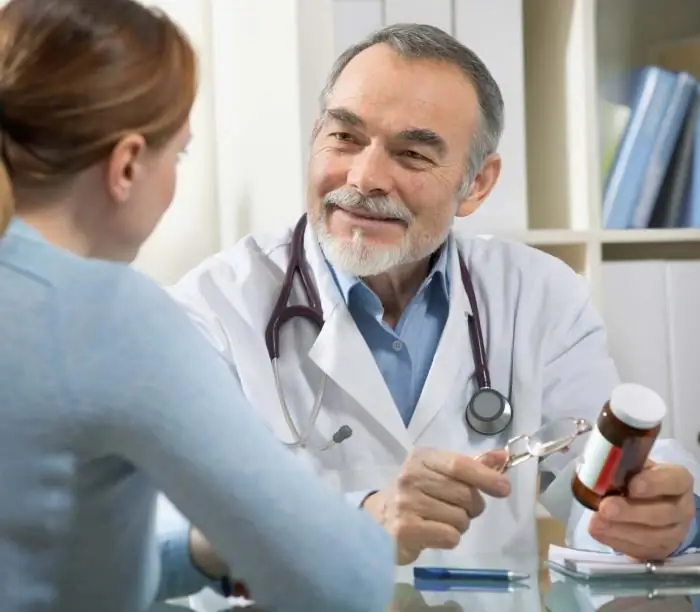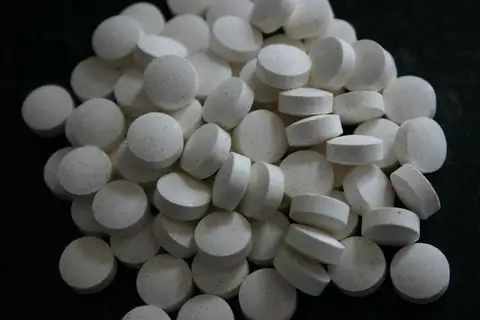- Author Curtis Blomfield [email protected].
- Public 2024-01-17 01:02.
- Last modified 2025-01-23 17:01.
Surely you have ever heard of steroid hormones. Our body continuously produces them to regulate vital processes. In this article, we will look at glucocorticoids, steroid hormones that are produced in the adrenal cortex. Although we are most interested in their synthetic counterparts - GCS. What is it in medicine? What are they used for and what harm do they cause? Let's see.

General information about GKS. What is it in medicine?
Our body synthesizes steroid hormones such as glucocorticoids. They are produced by the adrenal cortex and their use is mainly associated with the treatment of adrenal insufficiency. Nowadays, not only natural glucocorticoids are used, but also their synthetic analogues - GCS. What is it in medicine? For humanity, these analogs mean a lot, as they have anti-inflammatory, immunosuppressive, anti-shock, anti-allergic effects on the body.
Glucocorticoids began to be used asmedicines (hereinafter in the article - drugs) back in the 40s of the twentieth century. By the end of the 1930s, scientists discovered steroid hormone compounds in the human adrenal cortex, and already in 1937 the mineralocorticoid deoxycorticosterone was isolated. In the early 1940s, the glucocorticoids hydrocortisone and cortisone were also introduced. The pharmacological effects of cortisone and hydrocortisone were so diverse that it was decided to use them as drugs. After some time, scientists carried out their synthesis.
The most active glucocorticoid in the human body is cortisol (an analogue is hydrocortisone, the price of which is 100-150 rubles), and it is considered the main one. Less active ones can also be distinguished: corticosterone, cortisone, 11-deoxycortisol, 11-dehydrocorticosterone.
Of all the natural glucocorticoids, only hydrocortisone and cortisone have been used as drugs. However, the latter causes side effects more often than any other hormone, which is why its use in medicine is currently limited. To date, of the glucocorticoids, only hydrocortisone or its esters (hydrocortisone hemisuccinate and hydrocortisone acetate) are used.
As for glucocorticosteroids (synthetic glucocorticoids), in our time a number of such agents have been synthesized, among which fluorinated (flumethasone, triamcinolone, betamethasone, dexamethasone, etc.) and non-fluorinated (methylprednisolone, prednisolone, prednisone) glucocorticoids can be distinguished.
These remedies are more active than their natural counterparts and require lessdoses.
GCS action mechanism

The action of glucocorticosteroids at the molecular level has not been fully elucidated. Scientists believe that these drugs act on cells at the level of regulation of gene transcription.
Glucocorticosteroids interact with intracellular glucocorticoid receptors, which are present in almost every cell of the human body. In the absence of this hormone, the receptors (they are cytosolic proteins) are simply inactive. In an inactive state, they are part of heterocomplexes, which also include immunophilin, heat shock proteins, etc.
When glucocorticosteroids penetrate into the cell (through the membrane), they bind to receptors and activate the “glucocorticoid + receptor” complex, after which it penetrates into the cell nucleus and interacts with DNA regions that are located in the promoter fragment of the steroid-responding gene (they are also called glucocorticoid-responding elements). The “glucocorticoid + receptor” complex is able to regulate (suppress or, conversely, activate) the process of transcription of some genes. This is what leads to suppression or stimulation of mRNA formation, as well as changes in the synthesis of various regulatory enzymes and proteins that mediate cellular effects.
Various studies show that the glucocorticoid + receptor complex interacts with different transcription factors, such as nuclear factor kappa B (NF-kB) or transcription activator protein (AP-1), which regulategenes involved in the immune response and inflammation (adhesion molecules, genes for cytokines, proteinases, etc.).
Main effects of GCS
The effects of glucocorticosteroids on the human body are numerous. These hormones have antitoxic, antishock, immunosuppressive, antiallergic, desensitizing and anti-inflammatory effects. Let's take a closer look at how GCS work.
- Anti-inflammatory effect of corticosteroids. Due to the suppression of the activity of phospholipase A2. When this enzyme is inhibited in the human body, the liberation (release) of arachidonic acid is suppressed and the formation of some inflammatory mediators (such as prostaglandins, leukotrienes, troboxane, etc.) is inhibited. Moreover, taking glucocorticosteroids leads to a decrease in fluid exudation, vasoconstriction (narrowing) of capillaries, and improvement of microcirculation in the inflammation site.
- Antiallergic effect of GCS. Occurs as a result of a decrease in the secretion and synthesis of allergy mediators, a decrease in circulating basophils, inhibition of the release of histamine from basophils and sensitized mast cells, a decrease in the number of B- and T-lymphocytes, a decrease in the sensitivity of cells to allergy mediators, changes in the body's immune response, and inhibition of antibody formation.
- Immunosuppressive activity of corticosteroids. What is it in medicine? This means that the drugs inhibit immunogenesis, suppress the production of antibodies. Glucocorticosteroids inhibit the migration of bone marrow stem cells, inhibit the activity of B- and T-lymphocytes,inhibit the release of cytokines from macrophages and leukocytes.
- Antitoxic and antishock effect of corticosteroids. This effect of hormones is due to an increase in blood pressure in humans, as well as the activation of liver enzymes that are involved in the metabolism of xeno- and endobiotics.
- Mineralocorticoid activity. Glucocorticosteroids have the ability to retain sodium and water in the human body, stimulate the excretion of potassium. In this, synthetic substitutes are not as good as natural hormones, but they still have such an effect on the body.
Pharmacokinetics
By duration of action, systemic glucocorticosteroids can be divided into:
- Short-acting glucocorticosteroids (such as hydrocortisone, the price of which varies from 100 to 150 rubles).
- Glucocorticosteroids with an average duration of action (prednisolone (which has not very good reviews), methylprednisolone).
- Long acting glucocorticosteroids (triamcinolone acetonide, dexamethasone, betamethasone).
But glucocorticosteroids can be determined not only by the duration of action. Their classification can also be according to the method of administration:
- oral;
- intranasal;
- inhaled glucocorticosteroids.
This classification, however, only applies to systemic glucocorticosteroids.
There are also some preparations in the form of ointments and creams (local corticosteroids). For example, Afloderm. Reviews of such drugs are good.
Let's take a looktypes of systemic corticosteroids separately.

Oral glucocorticosteroids are perfectly absorbed in the gastrointestinal tract without causing problems. Actively bind to plasma proteins (transcortin, albumin). The maximum concentration of oral corticosteroids in the blood is reached 1.5 hours after ingestion. They undergo biotransformation in the liver, kidneys (partly) and other tissues by conjugation with sulfate or glucuronide.
Approximately 70% of conjugated corticosteroids are excreted in the urine, another 20% will be excreted later in the feces, and the rest in other body fluids (eg sweat). The half-life is 2 to 4 hours.
You can make a small table with the pharmacokinetic parameters of oral corticosteroids.
| Glucocorticosteroids. Preparations (names) | Tissue half-life | Plasma half-life |
| Hydrocortisone | 8-12 hours | 0.5-1.5 hours |
| Cortisone | 8-12 hours | 0, 7-2 hours |
| Prednisolone (not very good reviews) | 18-36 hours | 2-4 hours |
| Methylprednisolone | 18-36 hours | 2-4 hours |
| Fludrocortisone | 18-36 hours | 3, 5 hours |
| Dexamethasone | 36-54 hours | 5 hours |
Inhaled glucocorticosteroids in modern clinical practice are represented by triamcinolone acetonide, fluticasone propionate, mometasone furoate, budesonide and beclomethasone dipropionate.

Their pharmacokinetic parameters can also be presented as a table:
| Glucocorticosteroids. Preparations (names) | Topical anti-inflammatory activity | Volume of distribution | Plasma half-life | Hepatic passage efficiency |
| Beclomethasone dipropionate | 0, 64 units | - | 0, 5 hours | 70% |
| Budesonide | 1 u | 4, 3L/kg | 1, 7-3, 4 hours | 90% |
| Triamcinolone acetonide | 0, 27 units | 1, 2L/kg | 1, 4-2 hours | 80-90% |
| Fluticasone Propionate | 1 u | 3.7L/kg | 3, 1 hour | 99% |
| Flunisolide | 0, 34 units | 1.8L/kg | 1, 6 hours | - |
Intranasal glucocorticosteroids in modern medicine are represented by fluticasone propionate, flunisolide, triamcinolone acetonide, mometasone furoate, budesonide and beclomethasone dipropionate. Some of them are called the same as inhaled corticosteroids.
After the use of intranasal corticosteroids, part of the dose is absorbed in the intestine, and another part comes from the mucous membrane of the respiratory tract directly into the blood.
Glucocorticosteroids that enter the gastrointestinal tract are absorbed by about 1-8 percent and are almost completely biotransformed to inactive metabolites during the first passage through the liver.
Glucocorticosteroids that enter the blood are hydrolyzed to inactive substances. Here is a table with their pharmacokinetic parameters:
| Glucocorticosteroids. Drugs | Bioavailability when entering the blood, in percent | Bioavailability by absorption from the gastrointestinal tract, in percent |
| Budesonide | 34 | 11 |
| Beclomethasone dipropionate | 44 | 20-25 |
| Mometasone furoate | <0, 1 | <1 |
| Triamcinolone acetonide | No data | 10, 6-23 |
| Fluticasone propionate | 0, 5-2 | |
| Flunisolide | 40-50 | 21 |
Such drugs as "Afloderm" (reviews of which are increasingly appearing on the network), it makes no sense to describe separately. Each of them has the main active ingredient, which, most likely, has already been mentioned above. These drugs are topical glucocorticosteroids and are most often presented as ointments or creams.

The place of GCS in therapy (indications for use)
Each type of glucocorticosteroid has its own indications for use. So, oral glucocorticosteroids are used to treat:
- Crohn's disease;
- ulcerative colitis;
- interstitial lung disease;
- acute respiratory distress syndrome;
- severe pneumonia;
- chronic obstructive pulmonary disease in the acute phase;
- bronchial asthma;
- subacute thyroiditis;
- congenital dysfunction of the adrenal cortex (in this case, a person does not produce corticoids himself and is forced to take their synthetic analogues);
- acute adrenal insufficiency.
Also, glucocorticosteroids are used in replacement therapy for primary and secondary renal insufficiency.
Intranasal glucocorticosteroids are used for:
- idiopathic rhinitis (vasomotor);
- nonallergic rhinitis with eosinophilia;
- pilipose nose;
- perennial allergic rhinitis (persistent);
- seasonalallergic rhinitis (intermittent).
Inhaled corticosteroids are used in the treatment of chronic obstructive pulmonary disease, bronchial asthma.
Contraindications
GCS should be treated with caution in such clinical cases:
- lactation;
- glaucoma;
- some diseases of the cornea, which are combined with pathologies of the epithelium;
- fungal or viral eye diseases;
- purulent infections;
- vaccination period;
- syphilis;
- active tuberculosis;
- herpetic infection;
- systemic mycoses;
- some mental illness with productive symptoms;
- severe renal failure;
- arterial hypertension;
- thromboembolism;
- duodenal ulcer or stomach ulcer;
- diabetes mellitus;
- Itsenko-Cushing's disease.
Intranasal administration of corticosteroids is strictly contraindicated in such cases:
- history of frequent nosebleeds;
- hemorrhagic diathesis;
- hypersensitivity.
Glucocorticosteroids: side effects
Side effects of corticosteroids can be divided into local and systemic.
Local side effects
Divided into effects from inhaled and intranasal corticosteroids.
1. Local side effects of inhaled glucocorticosteroids:
- cough;
- dysphonia;
- candidiasis of the pharynx and oral cavity.
2. Local side effectsfrom intranasal corticosteroids:
- perforation of the nasal septum;
- nosebleeds;
- burning and dryness of the mucous membrane of the pharynx and nose;
- sneeze;
- itchy nose.
Systemic side effects
Divided according to the part of the body they are acting on.
1. From the side of the central nervous system:
- psychosis;
- depression;
- euphoria;
- insomnia;
- increased nervous excitability.
2. From the side of the cardiovascular system:
- thromboembolism;
- deep vein thrombosis;
- increased blood pressure;
- myocardial dystrophy.
3. From the reproductive system:
- hirsutism;
- delayed puberty;
- sexual dysfunction;
- unstable menstrual cycle.
4. From the digestive system:
- fatty liver;
- pancreatitis;
- GI bleeding;
- steroid ulcers of the intestines and stomach.
5. From the endocrine system:
- diabetes mellitus;
- Cushing's syndrome;
- obesity;
- atrophy of the adrenal cortex due to inhibition of its functions.
6. From the side of the organs of vision:
- glaucoma;
- posterior subcapsular cataract.
7. From the musculoskeletal system:
- muscle hypotrophy;
- myopathy;
- stunting in children;
- aseptic necrosis andbroken bones;
- osteoporosis.
8. From the side of the skin:
- alopecia;
- stretch marks;
- thinning skin.
9. Other side effects:
- exacerbation of chronic infectious and inflammatory processes;
- edema;
- water and sodium retention in the body.
Precautions

In some cases, glucocorticosteroids should be used with caution.
For example, in patients with cirrhosis of the liver, hypothyroidism, hypoalbuminemia, as well as in patients of senile or elderly age, the effect of GCS may increase.
When using corticosteroids during pregnancy, it is necessary to take into account the expected effect of the treatment for the mother and the risk of a negative effect of the drug on the fetus, since corticosteroids can lead to impaired fetal growth and even defects such as cleft palate, etc.
If during the use of corticosteroids the patient suffers an infectious disease (chickenpox, measles, etc.), it can be very difficult.
In the treatment of corticosteroids in patients with autoimmune or inflammatory diseases (rheumatoid arthritis, bowel disease, systemic lupus erythematosus, etc.), cases of steroid resistance may occur.
Patients receiving oral glucocorticosteroids for a long time should periodically take a stool test for occult blood and undergo fibroesophagogastroduodenoscopy, since steroid ulcers may not bother during treatment with GCS.
In 30-50% of patients,undergoing treatment with glucocorticosteroids for a long time, osteoporosis develops. As a rule, it affects the feet, hands, pelvic bones, ribs, spine.
Interaction with other drugs
All glucocorticosteroids (classification does not matter here) when in contact with other drugs give a certain effect, and this effect is not always positive for our body. Here's what you need to know before using glucocorticosteroids with other drugs:
- GCS and antacids - absorption of glucocorticosteroids decreases.
- GCS and barbiturates, diphenin, hexamidine, diphenhydramine, carbamazepine, rifampicin - biotransformation of glucocorticosteroids in the liver increases.
- GCS and isoniazid, erythromycin - the biotransformation of glucocorticosteroids in the liver is reduced.
- GCS and salicylates, butadione, barbiturates, digitoxin, penicillin, chloramphenicol - all of these drugs increase elimination.
- GCS and isoniazid - disorders of the human psyche.
- GCS and reserpine - the appearance of a depressive state.
- GCS and tricyclic antidepressants - increased intraocular pressure.
- GCS and adrenomimetics - the effect of these drugs is enhanced.
- GCS and theophylline - the anti-inflammatory effect of glucocorticosteroids is enhanced, cardiotoxic effects develop.
- GCS and diuretics, amphotericin, mineralocorticoids - increased risk of hypokalemia.
- GCS and indirect anticoagulants, fibrinolytics, butadine, ibuprofen, ethacrynic acid - hemorrhagic may followcomplications.
- GCS and indomethacin, salicylates - this combination can lead to ulcerative lesions of the digestive tract.
- GCS and paracetamol - the toxicity of this drug is increasing.
- GCS and azathioprine - increased risk of cataracts, myopathies.
- GCS and mercaptopurine - the combination can lead to an increase in the concentration of uric acid in the blood.
- GCS and Chingamine - the undesirable effects of this drug are enhanced (clouding of the cornea, myopathy, dermatitis).
- GCS and methandrostenolone - the undesirable effects of glucocorticosteroids are enhanced.
- GCS and iron preparations, androgens - an increase in the synthesis of erythropoietin, and against this background, an increase in erythropoiesis.
- GCS and hypoglycemic drugs - almost complete decrease in their effectiveness.

Conclusion
Glucocorticosteroids are drugs that modern medicine is unlikely to do without. They are used both for the treatment of very severe stages of diseases, and simply to enhance the effect of any drug. However, like all drugs, glucocorticosteroids also have side effects and contraindications. Don't forget about it. Above, we have listed all the cases when you should not use glucocorticosteroids, and also provided a list of interactions of GCS with other drugs. Also, the mechanism of action of GCS and all their effects was described in detail here. Now everything you need to know about GCS is in one place - this article. However, in no case should you start treatment onlyafter reading general information about GCS. These drugs, of course, can be purchased without a doctor's prescription, but why do you need it? Before using any medication, you must first consult a specialist. Stay he althy and don't self-medicate!






